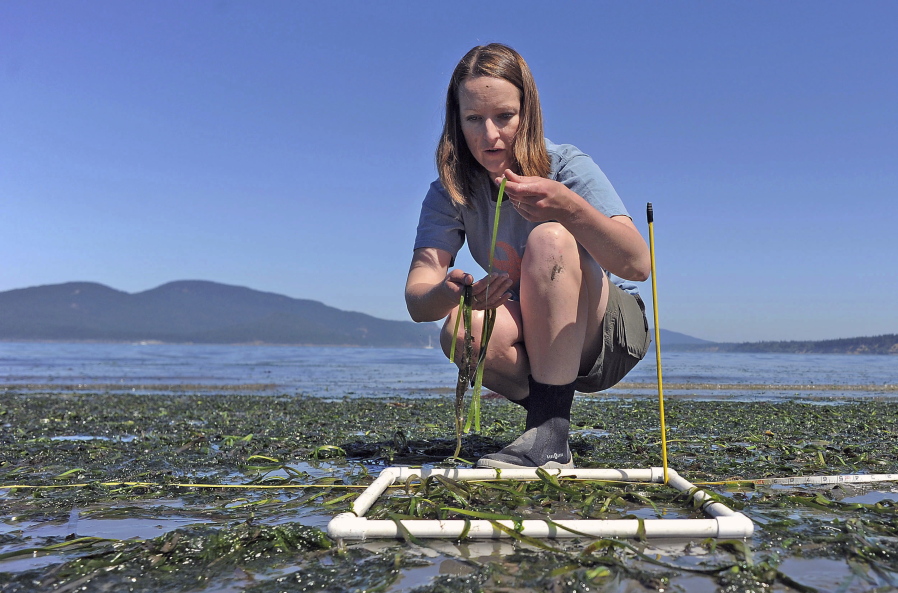ANACORTES — Squatting on a muddy beach on the north end of Fidalgo Island, Morgan Eisenlord untangled several slippery strands of eelgrass.
Most of the strands were a shiny green, similar to giant, damp blades of grass. Some bore patches of brown — a sign of eelgrass wasting disease.
Eisenlord — a Cornell University doctoral student doing her dissertation at the University of Washington’s Friday Harbor Labs — is searching for the disease in areas on Fidalgo Island and on the San Juan Islands.
“We know it’s here, it’s prevalent and it’s affecting eelgrass,” Eisenlord said of their findings.
The primary goal of Eisenlord and others working on the research is to document where in the region the disease is found and how much of the eelgrass in those areas is affected. That baseline data is needed in order to watch for changes in the future.
The researchers also hope to eventually answer questions such as how big of a threat the disease is in the Pacific Northwest, whether global climate change will amplify that threat and if anything can be done to prevent or stop the disease in the Salish Sea, which includes the Puget Sound, Strait of Juan de Fuca and Georgia Strait.
“We care a lot about eelgrass … In our waters it’s essential for both herring and salmon. A lot of herring spawn in eelgrass beds and a lot of salmon feed in eelgrass beds,” researcher Drew Harvell said. “Given that it’s such a really, really important marine habitat, anything that is contributing to its decline is a problem.”
Prevalent in region
Eelgrass wasting disease has long affected the important marine plant in parts of the world. The East Coast of the United States saw a steep decline in eelgrass beds during an outbreak of the disease in the 1930s, according to the National Oceanographic and Atmospheric Administration.
More recently, the disease was documented in the Pacific Northwest. The disease does not appear to have caused a major decline in area eelgrass beds, according to research being led by Harvell, a Cornell University professor.
After studying the impacts of other diseases on coral reefs, Harvell said she developed an interest in eelgrass wasting while working at Friday Harbor Labs on San Juan Island.
In 2012, she began teaching a graduate course there on marine disease ecology.
It was through that course — during which students surveyed eelgrass beds at 11 sites in the region for signs of wasting — that Harvell realized the disease was prevalent in area waters.
“We were impressed to see how high the level of infection was at some of our sites,” she said.
Since they started investigating eelgrass wasting disease in area waters, Harvell’s students have helped determine the disease is caused by a type of single-celled organism called protozoa and that there are multiple strains of the disease.
Affected parts of the leaves die, turn brown and can cause the portion of the leaves above the affected areas to break off and float away.
“We haven’t observed it actually killing the whole plant, but we are seeing it limiting growth,” Eisenlord said.
The data collected over the years has also shown that the presence of the disease increases during the summer.



